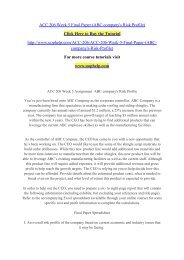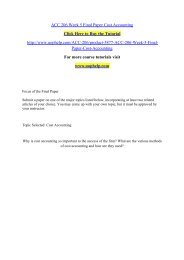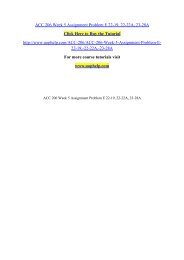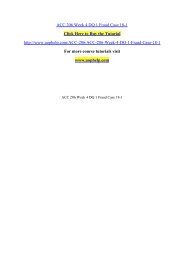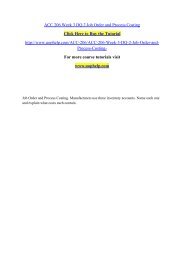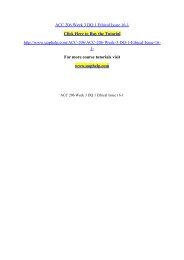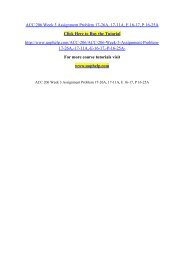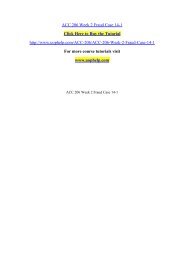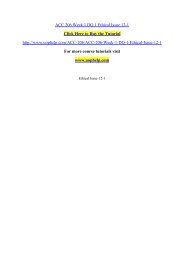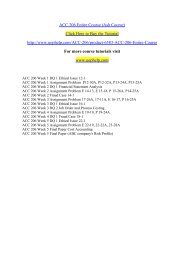ACC 205 Week 2 Exercise Assignment Revenue and Expenses/ UOPHELP
For more course tutorials visit www.uophelp.com 1. Recognition of concepts. Ron Carroll operates a small company that books entertainers for theaters, parties, conventions, and so forth. The company’s fiscal year ends on June 30. Consider the following items and classify each as either (1) prepaid expense, (2) unearned revenue, (3) accrued expense, (4) accrued revenue, or (5) none of the foregoing. a. Amounts paid on June 30 for a 1-year insurance policy b. Professional fees earned but not billed as of June 30 c. Repairs to the firm’s copy machine, incurred and paid in June d. An advance payment from a client for a performance next month at a convention e. The payment in part (d) from the client’s point of view f. Interest owed on the company’s bank loan, to be paid in early July g. The bank loan payable in part (f) h. Office supplies on hand at year-end
For more course tutorials visit
www.uophelp.com
1. Recognition of concepts. Ron Carroll operates a small company that books entertainers for theaters, parties, conventions, and so forth. The company’s fiscal year ends on June 30. Consider the following items and classify each as either (1) prepaid expense, (2) unearned revenue, (3) accrued expense, (4) accrued revenue, or (5) none of the foregoing.
a. Amounts paid on June 30 for a 1-year insurance policy
b. Professional fees earned but not billed as of June 30
c. Repairs to the firm’s copy machine, incurred and paid in June
d. An advance payment from a client for a performance next month at a convention
e. The payment in part (d) from the client’s point of view
f. Interest owed on the company’s bank loan, to be paid in early July
g. The bank loan payable in part (f)
h. Office supplies on hand at year-end
You also want an ePaper? Increase the reach of your titles
YUMPU automatically turns print PDFs into web optimized ePapers that Google loves.
9. Direct write-off <strong>and</strong> allowance methods: matching approach. The December 31, 20X2,<br />
year-end trial balance of Targa Company revealed the following account information:<br />
Debits<br />
Credits<br />
Accounts Receivable<br />
$252,000<br />
Allowance for Uncollectible Accounts<br />
$ 3,000<br />
Sales<br />
855,000<br />
Instructions<br />
a. Determine the adjusting entry for bad debts under each of the following conditions:<br />
(1) An aging schedule indicates that $12,420 of accounts receivable will be uncollectible.<br />
(2) Uncollectible accounts are estimated at 2% of net sales.<br />
b. On January 19, 20X3, Targa learned that House Company, a customer, had declared<br />
bankruptcy. Present the proper entry to write off House’s $950 balance using the allowance<br />
method.<br />
c. Repeat the requirement in part (b), using the direct write-off method.<br />
d. In light of the House bankruptcy, examine the allowance <strong>and</strong> direct write-off methods in<br />
terms of their ability to properly match revenues <strong>and</strong> expenses.<br />
10. Allowance method: analysis of receivables. At a January 20X2 meeting, the president of<br />
Sonic Sound directed the sales staff “to move some product this year.” The president noted<br />
that the credit evaluation department was being disb<strong>and</strong>ed because it had restricted the<br />
company’s growth. Credit decisions would now be made by the sales staff.<br />
By the end of the year, Sonic had generated significant gains in sales, <strong>and</strong> the president was<br />
very pleased. The following data were provided by the accounting department:<br />
20X2<br />
20X1



